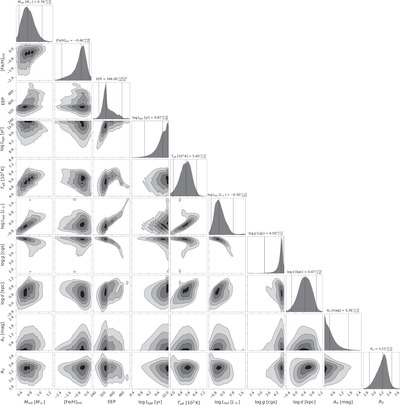Image Details

Caption: Figure 7.
A corner plot showing the collective 1D and 2D posterior distributions for the parameters constrained for each of the 125 million Augustus-Gold stars. These parameters are (from left to right): the initial mass (M init), initial metallicity ([Fe/H]init), EEP, age (﹩\mathrm{log}{t}_{\mathrm{age}}﹩), effective temperature (﹩\mathrm{log}{T}_{\mathrm{eff}}﹩), bolometric luminosity (﹩\mathrm{log}{L}_{\mathrm{bol}}﹩), surface gravity (﹩\mathrm{log}g﹩), distance ﹩\mathrm{log}d﹩, extinction (A V ), and “differential” extinction (R V ). The titles of each column show the median and the interval encompassing 95% of the sample. As expected, the majority the sample comprises sources with low extinction (A V ≲ 1 mag) and initial masses ranging from 0.55 M ⊙ < M init < 1.2 M ⊙, with the lower limit imposed by the lower M init bound on our underlying grid of stellar models. Gridding effects can be seen in a few panels.
Copyright and Terms & Conditions
© 2024. The Author(s). Published by the American Astronomical Society.












